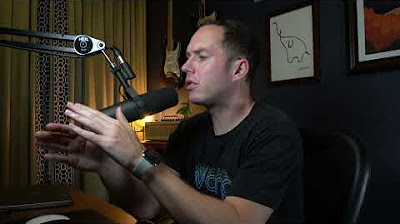PHP For Beginners, Ep 4 - Variables
Summary
TLDRThis video script introduces the basics of PHP, starting with echoing a 'Hello World' string. It explains how to open and close PHP tags within an HTML document and the importance of semicolons in PHP syntax. The tutorial then delves into string concatenation using the period operator and demonstrates creating and using variables to make greetings dynamic. It also touches on the difference between single and double quotes in PHP, emphasizing the need for double quotes to evaluate variables within strings. The script concludes with the concept of refactoring code for cleaner and more efficient programming practices.
Takeaways
- 😀 PHP can be mixed within any HTML document, which is unique to PHP.
- 🔑 Opening and closing PHP tags are used to define PHP code blocks within an HTML document.
- 📝 The 'echo' statement is used to output strings to the browser, and it requires a semicolon to end the command.
- 🔄 Concatenation in PHP is done using the period (.) operator, not the plus (+) symbol.
- 🌐 Variables in PHP are created using the dollar sign ($) followed by the variable name.
- 🔧 Variables can be used to store dynamic content, such as user input or database values.
- 💡 The use of variables allows for more flexible and dynamic programming, as opposed to static strings.
- 📌 Semicolons in PHP are used to terminate statements, similar to how periods end sentences in English.
- 📦 Double quotes allow for variable evaluation within strings, while single quotes treat the content as literal text.
- 🛠 Refactoring is the process of changing the code to improve its structure without altering the output for the user.
- 🔍 There are often multiple ways to achieve the same result in programming, each with its own advantages for readability or efficiency.
Q & A
What is the basic syntax for opening and closing a PHP tag?
-The basic syntax for opening a PHP tag is `<?php` and it is closed with `?>`.
How can PHP be integrated within an HTML document?
-PHP can be mixed within any HTML document, which is somewhat unique to PHP, and anything between the opening and closing PHP tags will be interpreted as PHP, not HTML.
What is the purpose of the 'echo' command in PHP?
-The 'echo' command in PHP is used to prepare a string and display it on the page.
What are the different types of quotes used in PHP for strings?
-In PHP, double quotes and single quotes can both be used for strings. Double quotes allow for variable interpolation, while single quotes treat the content as a literal string without evaluating variables.
How do you concatenate strings in PHP?
-In PHP, strings are concatenated using the '.' operator, not the '+' symbol as in some other languages.
What is the significance of a semicolon in PHP?
-A semicolon in PHP is used to end a statement or command, similar to a period concluding a sentence in English writing.
How can you make a part of the output dynamic in PHP?
-You can make a part of the output dynamic by using variables and concatenation to change the content on the fly.
What is a variable in PHP and how is it created?
-A variable in PHP is a way to store data that can be manipulated or changed during the execution of a script. It is created using the dollar sign followed by the variable name, for example, `$greeting = 'hello';`.
Why is it beneficial to use variables in PHP?
-Using variables in PHP is beneficial because they can point to data that the programmer does not have direct control over, such as user input, data from a database, or values that may be manipulated during script execution.
What is the difference between using single quotes and double quotes in PHP when dealing with strings that include variables?
-Single quotes treat the content as a literal string and do not evaluate variables within them, whereas double quotes allow for variable interpolation, meaning variables within double-quoted strings will be evaluated and replaced with their values.
What is refactoring in programming and why is it done?
-Refactoring in programming is the process of modifying and improving the existing code without changing its external behavior. It is done to make the code more efficient, clean, or easier to understand and maintain.
Outlines

This section is available to paid users only. Please upgrade to access this part.
Upgrade NowMindmap

This section is available to paid users only. Please upgrade to access this part.
Upgrade NowKeywords

This section is available to paid users only. Please upgrade to access this part.
Upgrade NowHighlights

This section is available to paid users only. Please upgrade to access this part.
Upgrade NowTranscripts

This section is available to paid users only. Please upgrade to access this part.
Upgrade NowBrowse More Related Video

PHP For Beginners, Ep 3 - Your First PHP Tag

Cara Memanipulasi String pada PHP yang harus dipahami Programmer | #9 - Belajar PHP Dasar

How To Install PHP & What Are Web Servers - PHP 8 Tutorial

Belajar PHP untuk PEMULA | 3. PERSIAPAN LINGKUNGAN PENGEMBANGAN

Hello World #2 | C++ | Bahasa Indonesia

Mahir PHP dalam 1 Jam (Part-1)
5.0 / 5 (0 votes)